Management and Leadership Perspectives: Analysis and Evaluation
VerifiedAdded on 2024/05/20
|7
|1426
|85
Report
AI Summary
This report provides a comprehensive analysis of leadership and management, highlighting their core differences, and critically evaluating various leadership styles and management theories. It examines the impact of these concepts on team working, using Harrods as a case study to illustrate practical applications. The report discusses autocratic, participative, transactional, transformational, and laissez-faire leadership styles, alongside management theories such as contingency, systems, chaos, and Theory X and Theory Y. The findings emphasize the importance of flexibility in leadership and management approaches to foster effective teamwork and achieve organizational goals.
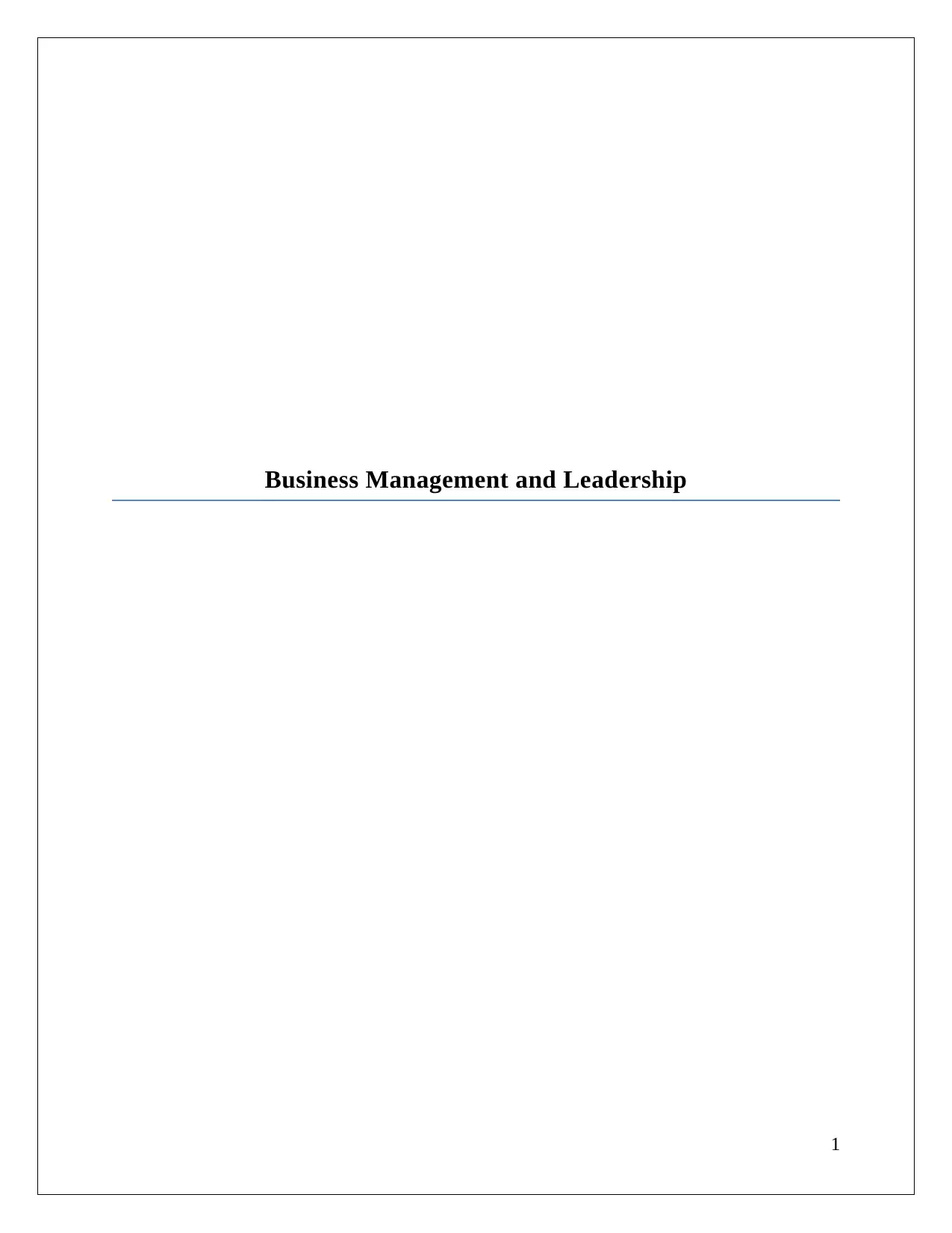
Business Management and Leadership
1
1
Paraphrase This Document
Need a fresh take? Get an instant paraphrase of this document with our AI Paraphraser

Table of Contents
Introduction......................................................................................................................................3
Differences between management and leadership...........................................................................3
Critical evaluation of leadership styles and management theory....................................................4
Impact of leadership and management on team working................................................................5
Conclusion.......................................................................................................................................6
References........................................................................................................................................7
2
Introduction......................................................................................................................................3
Differences between management and leadership...........................................................................3
Critical evaluation of leadership styles and management theory....................................................4
Impact of leadership and management on team working................................................................5
Conclusion.......................................................................................................................................6
References........................................................................................................................................7
2
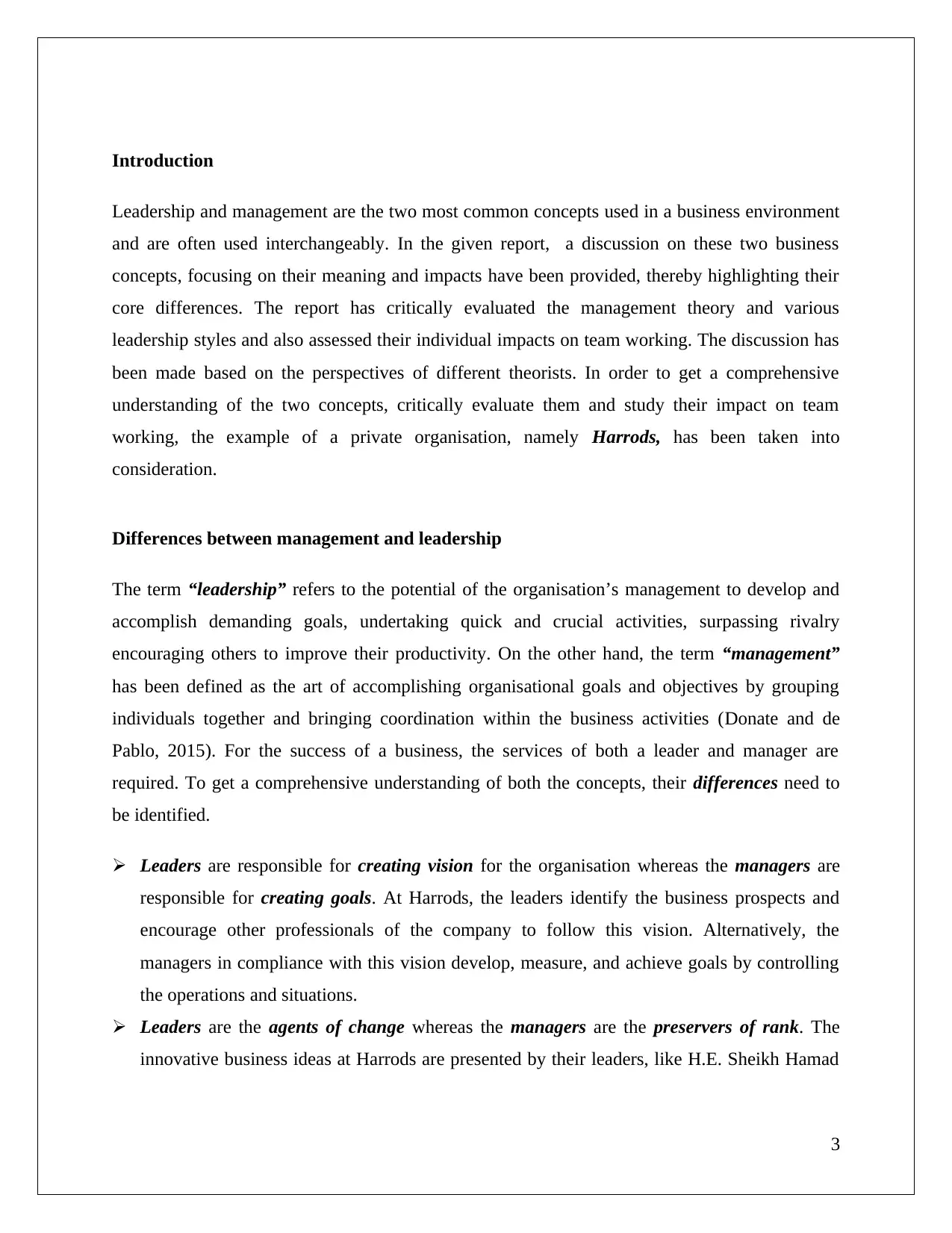
Introduction
Leadership and management are the two most common concepts used in a business environment
and are often used interchangeably. In the given report, a discussion on these two business
concepts, focusing on their meaning and impacts have been provided, thereby highlighting their
core differences. The report has critically evaluated the management theory and various
leadership styles and also assessed their individual impacts on team working. The discussion has
been made based on the perspectives of different theorists. In order to get a comprehensive
understanding of the two concepts, critically evaluate them and study their impact on team
working, the example of a private organisation, namely Harrods, has been taken into
consideration.
Differences between management and leadership
The term “leadership” refers to the potential of the organisation’s management to develop and
accomplish demanding goals, undertaking quick and crucial activities, surpassing rivalry
encouraging others to improve their productivity. On the other hand, the term “management”
has been defined as the art of accomplishing organisational goals and objectives by grouping
individuals together and bringing coordination within the business activities (Donate and de
Pablo, 2015). For the success of a business, the services of both a leader and manager are
required. To get a comprehensive understanding of both the concepts, their differences need to
be identified.
Leaders are responsible for creating vision for the organisation whereas the managers are
responsible for creating goals. At Harrods, the leaders identify the business prospects and
encourage other professionals of the company to follow this vision. Alternatively, the
managers in compliance with this vision develop, measure, and achieve goals by controlling
the operations and situations.
Leaders are the agents of change whereas the managers are the preservers of rank. The
innovative business ideas at Harrods are presented by their leaders, like H.E. Sheikh Hamad
3
Leadership and management are the two most common concepts used in a business environment
and are often used interchangeably. In the given report, a discussion on these two business
concepts, focusing on their meaning and impacts have been provided, thereby highlighting their
core differences. The report has critically evaluated the management theory and various
leadership styles and also assessed their individual impacts on team working. The discussion has
been made based on the perspectives of different theorists. In order to get a comprehensive
understanding of the two concepts, critically evaluate them and study their impact on team
working, the example of a private organisation, namely Harrods, has been taken into
consideration.
Differences between management and leadership
The term “leadership” refers to the potential of the organisation’s management to develop and
accomplish demanding goals, undertaking quick and crucial activities, surpassing rivalry
encouraging others to improve their productivity. On the other hand, the term “management”
has been defined as the art of accomplishing organisational goals and objectives by grouping
individuals together and bringing coordination within the business activities (Donate and de
Pablo, 2015). For the success of a business, the services of both a leader and manager are
required. To get a comprehensive understanding of both the concepts, their differences need to
be identified.
Leaders are responsible for creating vision for the organisation whereas the managers are
responsible for creating goals. At Harrods, the leaders identify the business prospects and
encourage other professionals of the company to follow this vision. Alternatively, the
managers in compliance with this vision develop, measure, and achieve goals by controlling
the operations and situations.
Leaders are the agents of change whereas the managers are the preservers of rank. The
innovative business ideas at Harrods are presented by their leaders, like H.E. Sheikh Hamad
3
⊘ This is a preview!⊘
Do you want full access?
Subscribe today to unlock all pages.

Trusted by 1+ million students worldwide
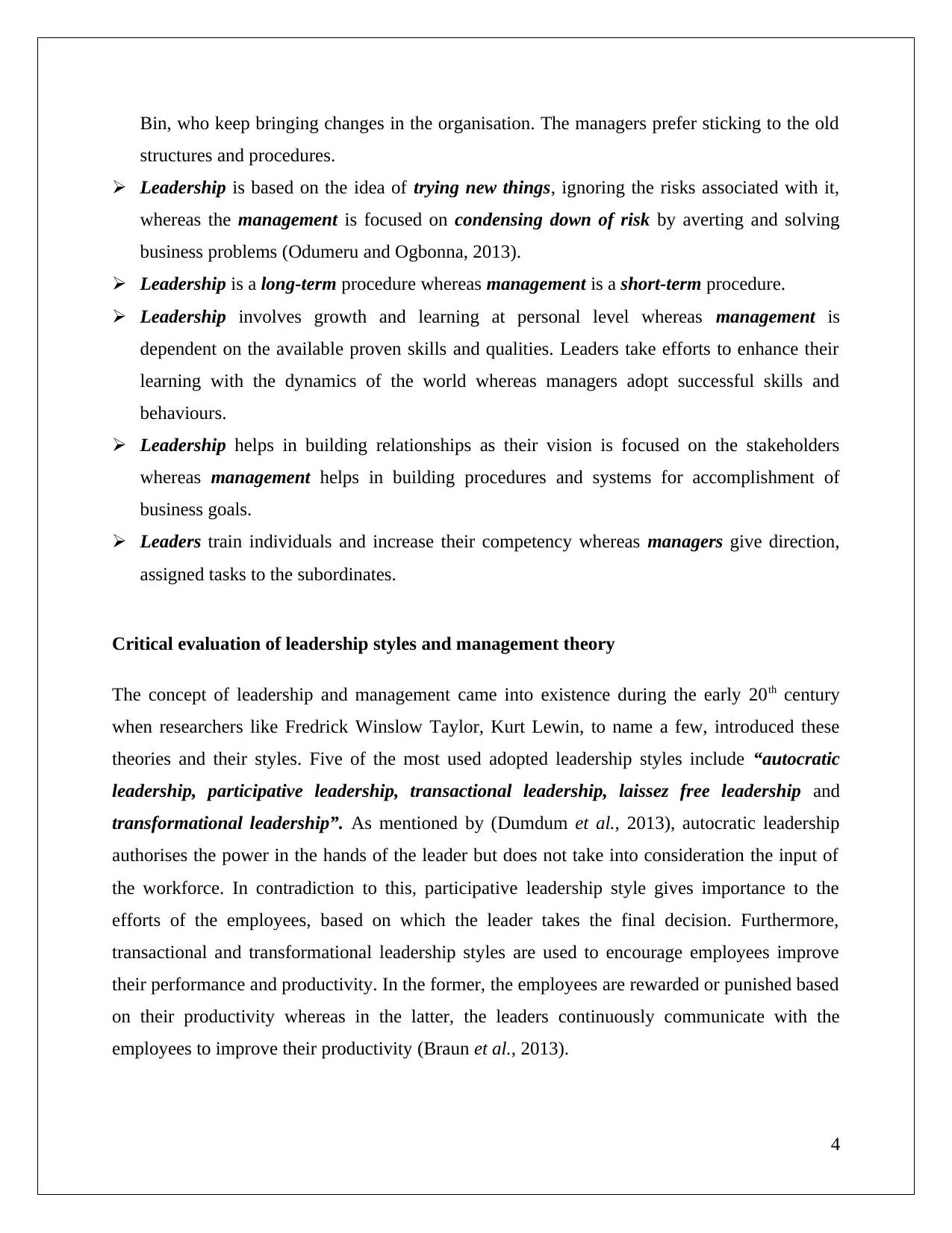
Bin, who keep bringing changes in the organisation. The managers prefer sticking to the old
structures and procedures.
Leadership is based on the idea of trying new things, ignoring the risks associated with it,
whereas the management is focused on condensing down of risk by averting and solving
business problems (Odumeru and Ogbonna, 2013).
Leadership is a long-term procedure whereas management is a short-term procedure.
Leadership involves growth and learning at personal level whereas management is
dependent on the available proven skills and qualities. Leaders take efforts to enhance their
learning with the dynamics of the world whereas managers adopt successful skills and
behaviours.
Leadership helps in building relationships as their vision is focused on the stakeholders
whereas management helps in building procedures and systems for accomplishment of
business goals.
Leaders train individuals and increase their competency whereas managers give direction,
assigned tasks to the subordinates.
Critical evaluation of leadership styles and management theory
The concept of leadership and management came into existence during the early 20th century
when researchers like Fredrick Winslow Taylor, Kurt Lewin, to name a few, introduced these
theories and their styles. Five of the most used adopted leadership styles include “autocratic
leadership, participative leadership, transactional leadership, laissez free leadership and
transformational leadership”. As mentioned by (Dumdum et al., 2013), autocratic leadership
authorises the power in the hands of the leader but does not take into consideration the input of
the workforce. In contradiction to this, participative leadership style gives importance to the
efforts of the employees, based on which the leader takes the final decision. Furthermore,
transactional and transformational leadership styles are used to encourage employees improve
their performance and productivity. In the former, the employees are rewarded or punished based
on their productivity whereas in the latter, the leaders continuously communicate with the
employees to improve their productivity (Braun et al., 2013).
4
structures and procedures.
Leadership is based on the idea of trying new things, ignoring the risks associated with it,
whereas the management is focused on condensing down of risk by averting and solving
business problems (Odumeru and Ogbonna, 2013).
Leadership is a long-term procedure whereas management is a short-term procedure.
Leadership involves growth and learning at personal level whereas management is
dependent on the available proven skills and qualities. Leaders take efforts to enhance their
learning with the dynamics of the world whereas managers adopt successful skills and
behaviours.
Leadership helps in building relationships as their vision is focused on the stakeholders
whereas management helps in building procedures and systems for accomplishment of
business goals.
Leaders train individuals and increase their competency whereas managers give direction,
assigned tasks to the subordinates.
Critical evaluation of leadership styles and management theory
The concept of leadership and management came into existence during the early 20th century
when researchers like Fredrick Winslow Taylor, Kurt Lewin, to name a few, introduced these
theories and their styles. Five of the most used adopted leadership styles include “autocratic
leadership, participative leadership, transactional leadership, laissez free leadership and
transformational leadership”. As mentioned by (Dumdum et al., 2013), autocratic leadership
authorises the power in the hands of the leader but does not take into consideration the input of
the workforce. In contradiction to this, participative leadership style gives importance to the
efforts of the employees, based on which the leader takes the final decision. Furthermore,
transactional and transformational leadership styles are used to encourage employees improve
their performance and productivity. In the former, the employees are rewarded or punished based
on their productivity whereas in the latter, the leaders continuously communicate with the
employees to improve their productivity (Braun et al., 2013).
4
Paraphrase This Document
Need a fresh take? Get an instant paraphrase of this document with our AI Paraphraser
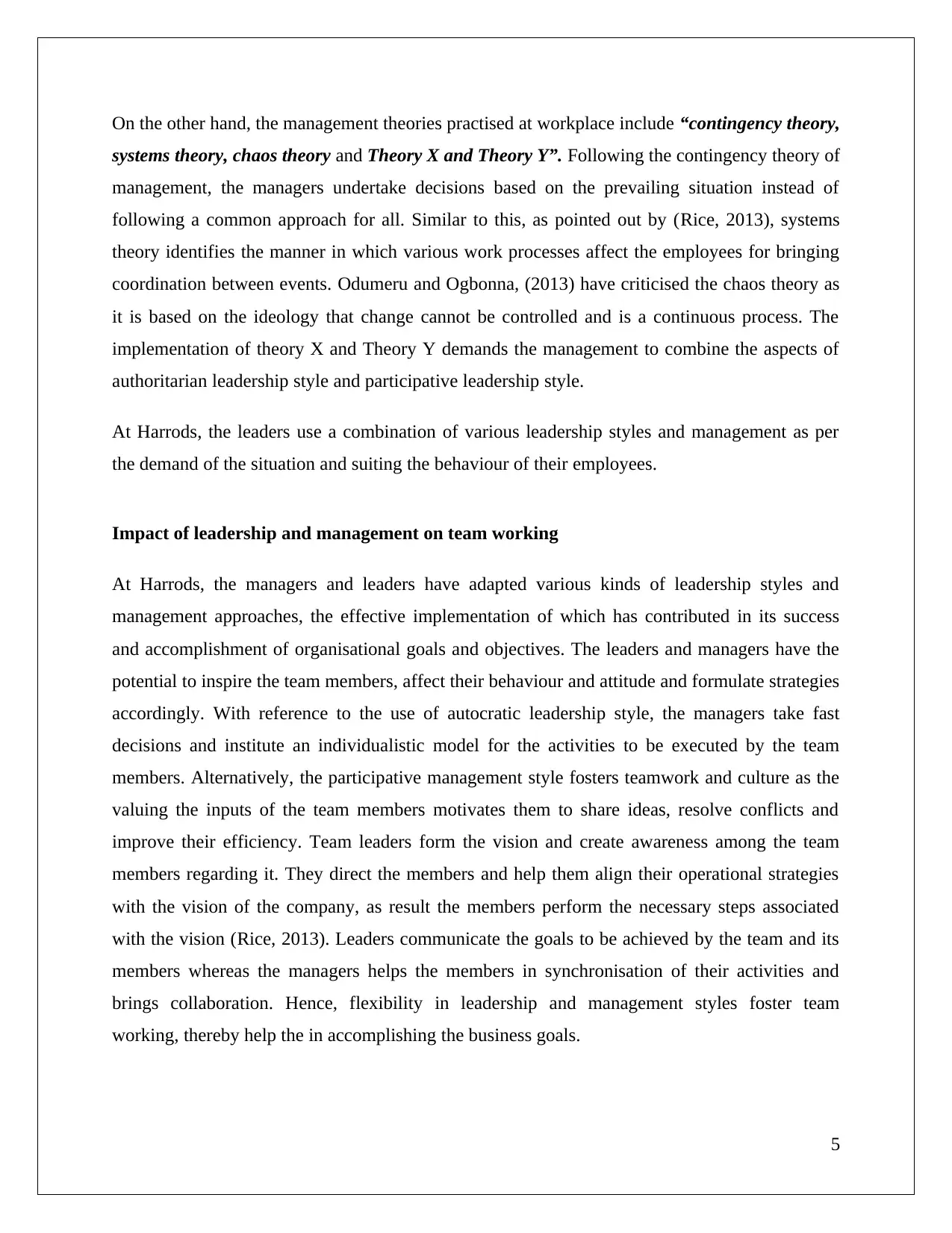
On the other hand, the management theories practised at workplace include “contingency theory,
systems theory, chaos theory and Theory X and Theory Y”. Following the contingency theory of
management, the managers undertake decisions based on the prevailing situation instead of
following a common approach for all. Similar to this, as pointed out by (Rice, 2013), systems
theory identifies the manner in which various work processes affect the employees for bringing
coordination between events. Odumeru and Ogbonna, (2013) have criticised the chaos theory as
it is based on the ideology that change cannot be controlled and is a continuous process. The
implementation of theory X and Theory Y demands the management to combine the aspects of
authoritarian leadership style and participative leadership style.
At Harrods, the leaders use a combination of various leadership styles and management as per
the demand of the situation and suiting the behaviour of their employees.
Impact of leadership and management on team working
At Harrods, the managers and leaders have adapted various kinds of leadership styles and
management approaches, the effective implementation of which has contributed in its success
and accomplishment of organisational goals and objectives. The leaders and managers have the
potential to inspire the team members, affect their behaviour and attitude and formulate strategies
accordingly. With reference to the use of autocratic leadership style, the managers take fast
decisions and institute an individualistic model for the activities to be executed by the team
members. Alternatively, the participative management style fosters teamwork and culture as the
valuing the inputs of the team members motivates them to share ideas, resolve conflicts and
improve their efficiency. Team leaders form the vision and create awareness among the team
members regarding it. They direct the members and help them align their operational strategies
with the vision of the company, as result the members perform the necessary steps associated
with the vision (Rice, 2013). Leaders communicate the goals to be achieved by the team and its
members whereas the managers helps the members in synchronisation of their activities and
brings collaboration. Hence, flexibility in leadership and management styles foster team
working, thereby help the in accomplishing the business goals.
5
systems theory, chaos theory and Theory X and Theory Y”. Following the contingency theory of
management, the managers undertake decisions based on the prevailing situation instead of
following a common approach for all. Similar to this, as pointed out by (Rice, 2013), systems
theory identifies the manner in which various work processes affect the employees for bringing
coordination between events. Odumeru and Ogbonna, (2013) have criticised the chaos theory as
it is based on the ideology that change cannot be controlled and is a continuous process. The
implementation of theory X and Theory Y demands the management to combine the aspects of
authoritarian leadership style and participative leadership style.
At Harrods, the leaders use a combination of various leadership styles and management as per
the demand of the situation and suiting the behaviour of their employees.
Impact of leadership and management on team working
At Harrods, the managers and leaders have adapted various kinds of leadership styles and
management approaches, the effective implementation of which has contributed in its success
and accomplishment of organisational goals and objectives. The leaders and managers have the
potential to inspire the team members, affect their behaviour and attitude and formulate strategies
accordingly. With reference to the use of autocratic leadership style, the managers take fast
decisions and institute an individualistic model for the activities to be executed by the team
members. Alternatively, the participative management style fosters teamwork and culture as the
valuing the inputs of the team members motivates them to share ideas, resolve conflicts and
improve their efficiency. Team leaders form the vision and create awareness among the team
members regarding it. They direct the members and help them align their operational strategies
with the vision of the company, as result the members perform the necessary steps associated
with the vision (Rice, 2013). Leaders communicate the goals to be achieved by the team and its
members whereas the managers helps the members in synchronisation of their activities and
brings collaboration. Hence, flexibility in leadership and management styles foster team
working, thereby help the in accomplishing the business goals.
5
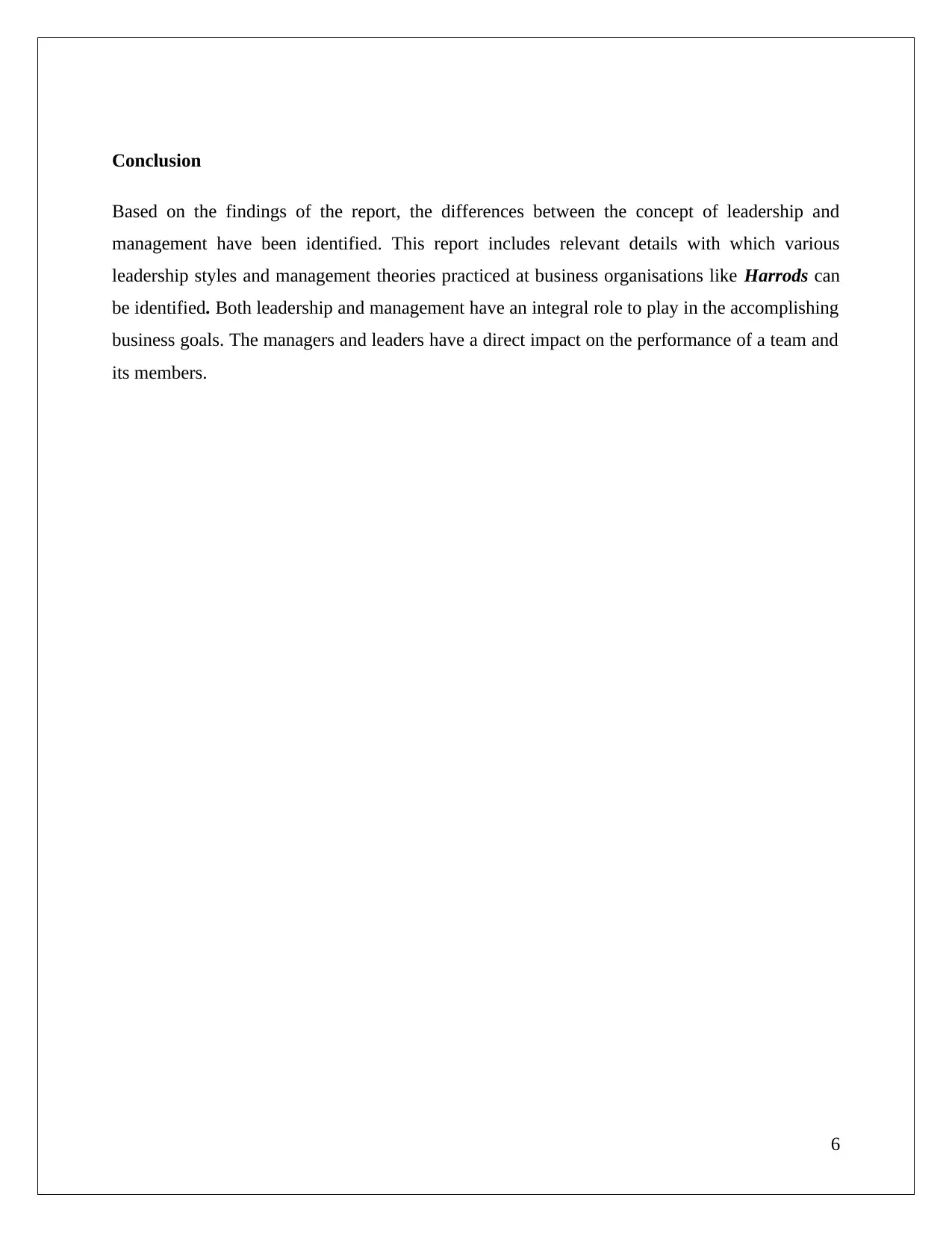
Conclusion
Based on the findings of the report, the differences between the concept of leadership and
management have been identified. This report includes relevant details with which various
leadership styles and management theories practiced at business organisations like Harrods can
be identified. Both leadership and management have an integral role to play in the accomplishing
business goals. The managers and leaders have a direct impact on the performance of a team and
its members.
6
Based on the findings of the report, the differences between the concept of leadership and
management have been identified. This report includes relevant details with which various
leadership styles and management theories practiced at business organisations like Harrods can
be identified. Both leadership and management have an integral role to play in the accomplishing
business goals. The managers and leaders have a direct impact on the performance of a team and
its members.
6
⊘ This is a preview!⊘
Do you want full access?
Subscribe today to unlock all pages.

Trusted by 1+ million students worldwide
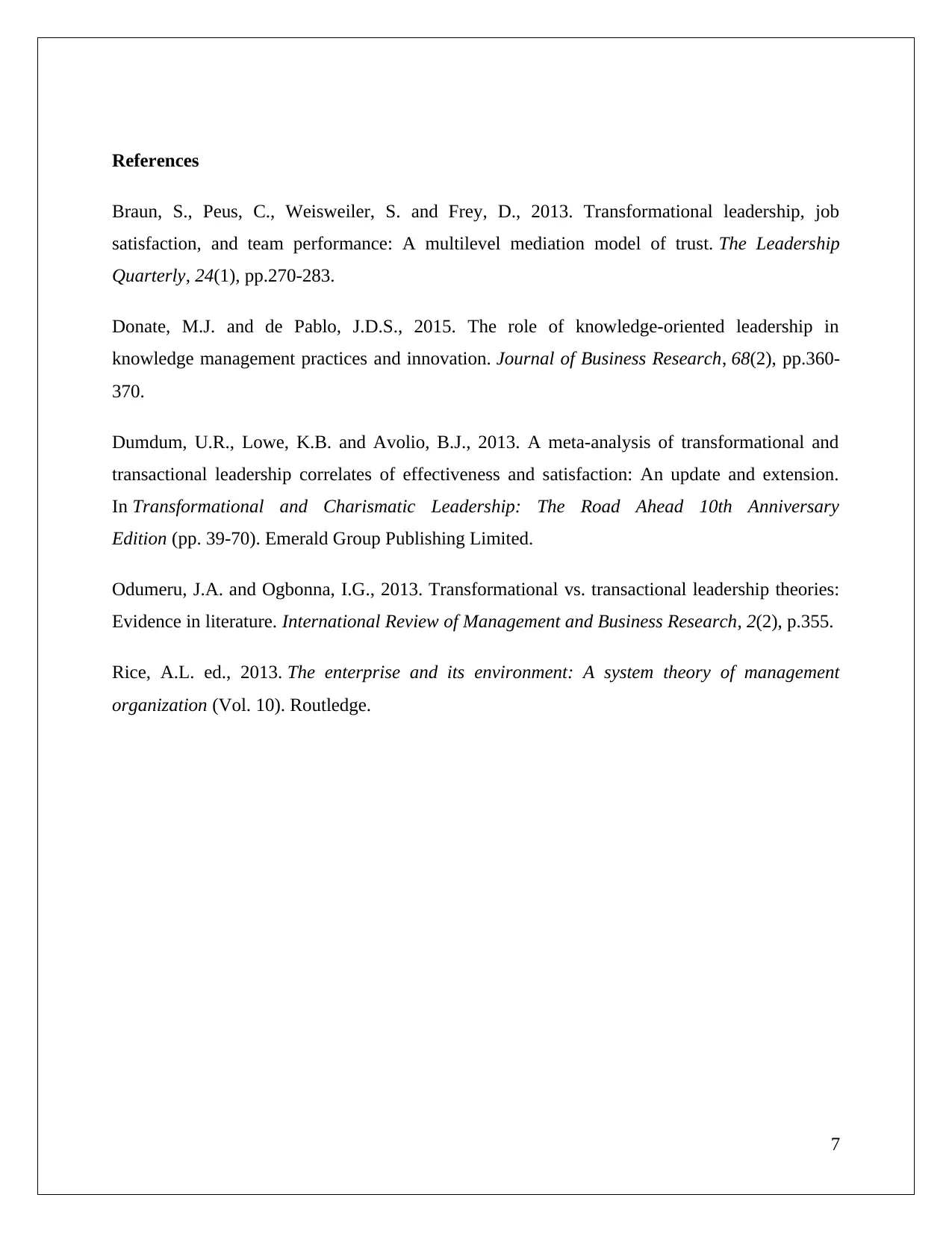
References
Braun, S., Peus, C., Weisweiler, S. and Frey, D., 2013. Transformational leadership, job
satisfaction, and team performance: A multilevel mediation model of trust. The Leadership
Quarterly, 24(1), pp.270-283.
Donate, M.J. and de Pablo, J.D.S., 2015. The role of knowledge-oriented leadership in
knowledge management practices and innovation. Journal of Business Research, 68(2), pp.360-
370.
Dumdum, U.R., Lowe, K.B. and Avolio, B.J., 2013. A meta-analysis of transformational and
transactional leadership correlates of effectiveness and satisfaction: An update and extension.
In Transformational and Charismatic Leadership: The Road Ahead 10th Anniversary
Edition (pp. 39-70). Emerald Group Publishing Limited.
Odumeru, J.A. and Ogbonna, I.G., 2013. Transformational vs. transactional leadership theories:
Evidence in literature. International Review of Management and Business Research, 2(2), p.355.
Rice, A.L. ed., 2013. The enterprise and its environment: A system theory of management
organization (Vol. 10). Routledge.
7
Braun, S., Peus, C., Weisweiler, S. and Frey, D., 2013. Transformational leadership, job
satisfaction, and team performance: A multilevel mediation model of trust. The Leadership
Quarterly, 24(1), pp.270-283.
Donate, M.J. and de Pablo, J.D.S., 2015. The role of knowledge-oriented leadership in
knowledge management practices and innovation. Journal of Business Research, 68(2), pp.360-
370.
Dumdum, U.R., Lowe, K.B. and Avolio, B.J., 2013. A meta-analysis of transformational and
transactional leadership correlates of effectiveness and satisfaction: An update and extension.
In Transformational and Charismatic Leadership: The Road Ahead 10th Anniversary
Edition (pp. 39-70). Emerald Group Publishing Limited.
Odumeru, J.A. and Ogbonna, I.G., 2013. Transformational vs. transactional leadership theories:
Evidence in literature. International Review of Management and Business Research, 2(2), p.355.
Rice, A.L. ed., 2013. The enterprise and its environment: A system theory of management
organization (Vol. 10). Routledge.
7
1 out of 7
Related Documents
Your All-in-One AI-Powered Toolkit for Academic Success.
+13062052269
info@desklib.com
Available 24*7 on WhatsApp / Email
![[object Object]](/_next/static/media/star-bottom.7253800d.svg)
Unlock your academic potential
Copyright © 2020–2025 A2Z Services. All Rights Reserved. Developed and managed by ZUCOL.




